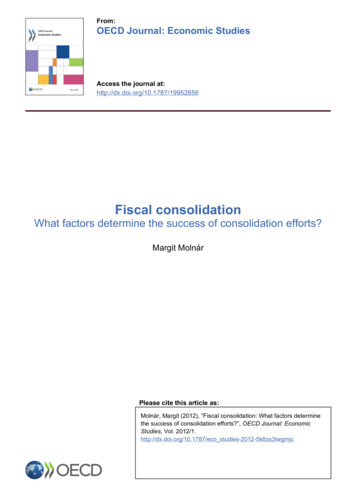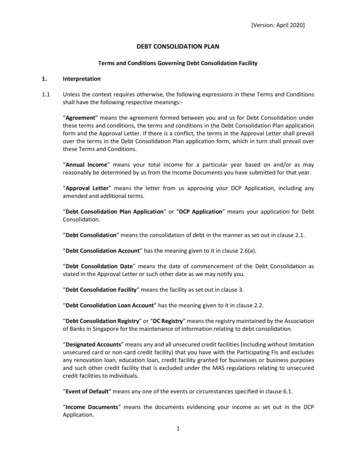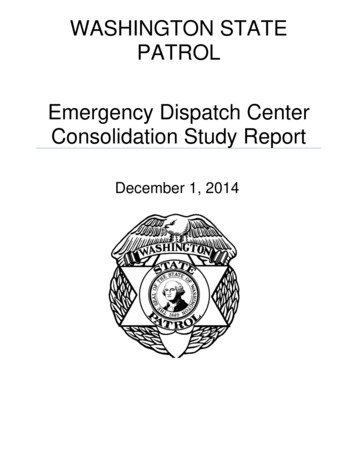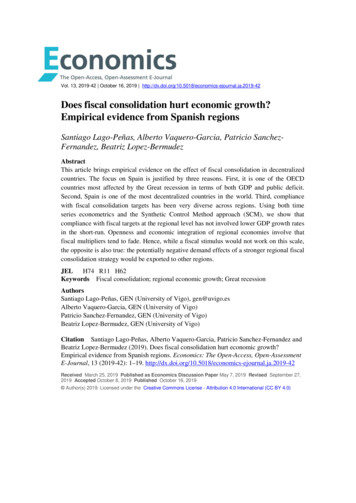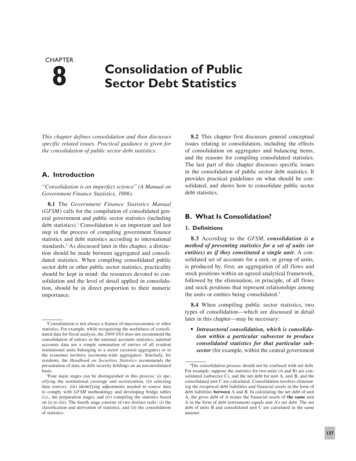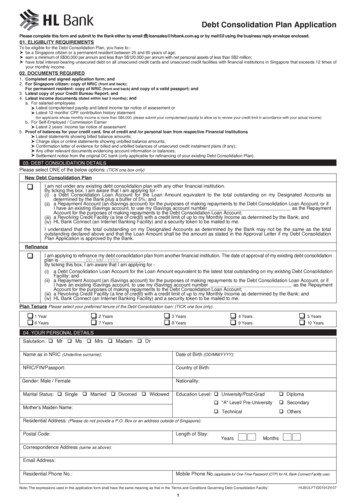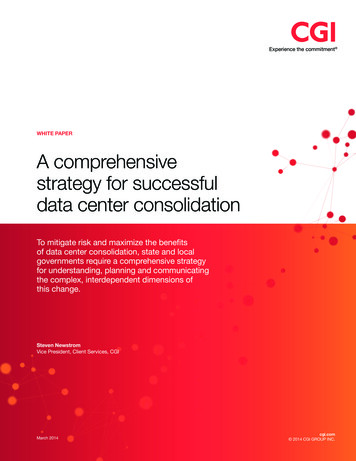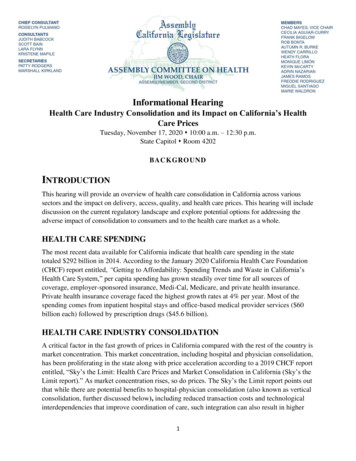
Transcription
Informational HearingHealth Care Industry Consolidation and its Impact on California’s HealthCare PricesTuesday, November 17, 2020 10:00 a.m. – 12:30 p.m.State Capitol Room 4202BACKGROUNDINTRODUCTIONThis hearing will provide an overview of health care consolidation in California across varioussectors and the impact on delivery, access, quality, and health care prices. This hearing will includediscussion on the current regulatory landscape and explore potential options for addressing theadverse impact of consolidation to consumers and to the health care market as a whole.HEALTH CARE SPENDINGThe most recent data available for California indicate that health care spending in the statetotaled 292 billion in 2014. According to the January 2020 California Health Care Foundation(CHCF) report entitled, “Getting to Affordability: Spending Trends and Waste in California’sHealth Care System,” per capita spending has grown steadily over time for all sources ofcoverage, employer-sponsored insurance, Medi-Cal, Medicare, and private health insurance.Private health insurance coverage faced the highest growth rates at 4% per year. Most of thespending comes from inpatient hospital stays and office-based medical provider services ( 60billion each) followed by prescription drugs ( 45.6 billion).HEALTH CARE INDUSTRY CONSOLIDATIONA critical factor in the fast growth of prices in California compared with the rest of the country ismarket concentration. This market concentration, including hospital and physician consolidation,has been proliferating in the state along with price acceleration according to a 2019 CHCF reportentitled, “Sky’s the Limit: Health Care Prices and Market Consolidation in California (Sky’s theLimit report).” As market concentration rises, so do prices. The Sky’s the Limit report points outthat while there are potential benefits to hospital-physician consolidation (also known as verticalconsolidation, further discussed below), including reduced transaction costs and technologicalinterdependencies that improve coordination of care, such integration can also result in higher1
prices, particularly when the hospital or physician organization has significant share in itsmarket. The combined effect of higher hospital and physician prices results in higher healthinsurance premiums, making healthcare even more unaffordable.A common type of health care industry consolidation is horizontal consolidation (orconcentration) which refers to the merger of the same type of entities, such as two hospitals. Oneway to measure hospital concentration and its impact on competition is the HerfindahlHirschmann Index (HHI), which is used by the Federal Trade Commission (FTC) and theDepartment of Justice (DoJ). HHI measures market concentration on a range from zero to10,000. Markets with HHIs between 1,500 and 2,500 points are considered to be moderatelyconcentrated and those with HHIs in excess of 2,500 points are considered to be highlyconcentrated. Mergers that would increase the HHI in a market by over 200 points and leave themarket with an HHI over 2,500 are assigned the highest level of concern and scrutiny accordingto DoJ/FTC guidelines because of their impact on competition and prices.A typical argument in favor of hospital consolidation is that efficiency improvements will resultfrom economies of scale and eliminate redundant services and that improvements in quality ofcare are possible through enhanced care coordination and sustained capital investment to expandclinical services. Stroke intervention and post-stroke care are examples of how hospitalconsolidation can improve outcomes and potentially reduce costs.Another type of consolidation is “vertical consolidation.” According to a 2019 CHCF blog, verticalconsolidation (sometimes also called vertical integration) occurs when entities at different levels ofthe health care supply chain combine, such as when hospitals acquire physician practices or healthplans acquire pharmacy benefit managers. Academic and political interest in vertical consolidationhas increased as the rate of independent practices being acquired by hospitals has accelerated.Analysis by the Physicians Advocacy Institute and Avalere Health found that in California the totalshare of physician practices owned by hospitals increased from 14% in 2012 to 31% in 2018. A2018 study published in Health Affairs found that between 2010 and 2016, the percentage ofCalifornia physicians in practices owned by a hospital increased from 25% to over 40%. Theestimated impact of the increase in vertical consolidation from 2013 to 2016 in highly concentratedhospital markets was found to be associated with a 12% increase in healthcare premiums. Forphysician outpatient services, the increase in vertical consolidation was also associated with a 9%increase in specialist prices and a 5% increase in primary care prices.In California, a 2018 report by the University of California at Berkeley Petris Center (PetrisCenter report) on consolidation in California’s health care market found that of the 54 Californiacounties with a hospital, 44 were highly concentrated (HHI above 2,500) and six weremoderately concentrated (HHI between 1,500 and 2,500). The mean HHI across the 54 countiesanalyzed was a staggering 5,613 in 2016. The Sky’s the Limit report found that prices for bothinpatient and outpatient services rise when market concentration increases. An example on theinpatient side is the association between cesarean delivery price and horizontal concentration of2
hospitals. For cesarean births without complications, a 10% rise in hospital HHI is associatedwith a 1.3% increase in price. An increase in hospital HHI from 1,500 to 2,500 would beassociated with an increase in price of 1,152 ( 16,386 to 17,538). Outpatient services pricesalso respond to market consolidation. For example, there is a relationship between head scanprices and horizontal and vertical concentration of radiologists. A 10% increase in radiologistHHI is associated with a 1.4% increase in price. An increase in radiologist HHI from 1,500 to2,500 would be associated with an increase in price of 44 ( 566 to 610).Consolidation is also growing in the health care insurance industry. In 2015, there were at leastfour health insurance company mergers considered with implications nationally and inCalifornia: Blue Shield of California's acquisition of Care 1st, Aetna's acquisition of Humana,Anthem's acquisition of Cigna, and Centene's acquisition of Health Net. These mergers wouldhave reduced the top five plans to three. While the Blue Shield-Care 1st and Centene-Health Netmergers were permitted, the DoJ blocked both the Anthem-Cigna and the Aetna-Humanamergers as anticompetitive. Anthem's acquisition of Cigna would have made it the largest healthinsurance company in the U.S. putting United Health into second place. An August 2015analysis by Cattaneo and Stroud on the impacts of these proposed mergers in California indicatedthat there would have been minor changes in enrollment numbers resulting in three plansrepresenting 55% of the market, but there would also have been fewer competitors in manycounties. With the Anthem-Cigna merger, competitiveness would have been reduced in 31counties and Aetna-Humana would have reduced competitiveness in eight counties. While thestudy concluded that major concentration had already occurred prior to the proposed mergersand/or acquisition, the proposed transactions would have further exacerbated the concentrations.There would have been a reduction of competing plans in the majority of California counties,which would likely have resulted in increased contracting pressure on delegated medical groups.Finally, less pronounced in scope and impact, is prescription drug market consolidation.According to a 2019 Drug Channels article, for 2018, about three-quarters of all equivalentprescription claims were processed by three pharmacy benefit management (PBM) companies:CVS Health (including Caremark and Aetna), Express Scripts, and the OptumRx business ofUnitedHealth. The top six PBMs handle more than 95% of total U.S. equivalent prescriptionclaims. This concentration helps plan sponsors and payers, who can maximize their negotiatingleverage by combining their prescription volumes within a small number of PBMs. Five of thelargest PBMs are combined into companies that offer health insurance and operate specialtypharmacies. This vertical integration is motivated partly by the ongoing growth in specialtydrugs. These drugs treat a small minority of patients, but they account for a high and growingshare of payers’ drug spending. Specialty drug spending, however, is split between the pharmacybenefit and the medical benefit. Patients who take expensive specialty drugs tend to have highmedical expenses.A 2019 University of Arizona study, entitled “Mergers, Product Prices, and Innovation:Evidence from the Pharmaceutical Industry,” examined the impact of mergers on product prices3
(including prescription drug prices) and innovation using novel data from the pharmaceuticalindustry. The study cited that the price of Celgene's top selling drug Revlimid rose 3.5% on theday its planned deal with Bristol-Myers Squibb was announced. The study found that productprices increase approximately 5% more within acquiring versus matched non-acquiring firms.These price increases are more pronounced for horizontal mergers and for acquisitions of largeand publicly traded targets.PRICINGAs indicated above, lack of competition impacts the overall costs of healthcare, and this lack ofcompetition is exacerbated by multi-hospital systems, which are often involved in many types ofmergers and consolidations. A 2016 study published in the Journal of Health Care Organization,Provision and Financing examined hospital prices in California over time with a focus onhospitals in the largest multi-hospital systems. The data showed that hospital prices in Californiagrew substantially ( 76% per hospital admission) across all hospitals and all services between2004 and 2013, and that prices at hospitals that are members of the largest, multi-hospitalsystems grew substantially more (113%) than prices paid to all other California hospitals (70%).The study noted that the substantial price differential was not driven by other factors such as casemix, payor mix, and changes in local wage costs and local market competition or other hospitalcharacteristics.A 2018 study published in the Journal of Health Economics titled, “The effect of hospitalacquisitions of physician practices on prices and spending,” noted that during the past decade,U.S. hospitals have acquired a large number of physician practices. For example, from 2007 to2013, hospitals acquired nearly 10% of the physician practices in the study. According to thestudy, the prices for the services provided by acquired physicians increased by an average of14.1% post-acquisition. Nearly half of this increase is attributable to the exploitation of paymentrules where price increases are larger when the acquiring hospital has a larger share of theinpatient market. The study found that consolidation/acquisition of primary care physicianpractices increase enrollee spending by 4.9%.EFFECTS OF CONSOLIDATION ON CONSUMERSIn a Commonwealth Fund-supported study in Health Affairs, researchers explored the effect ofmarket consolidation across California between 2010 and 2016 on outpatient visit prices andpremiums for individual coverage on the Covered California marketplace. The study concludedthat consolidation among health care providers and health plans has the potential to improve thecoordination and quality of patient care. However, when markets become highly concentrated,served by a single or a few large health care organizations, competition is curtailed and healthcare prices and insurance premiums tend to rise.Recently, the Sky’s the Limit report points out that California pays more for common health careservices that the rest of the country. Due in large part to market consolidation, there is also wide4
price disparity in health care prices and premiums across the state. For example, vaginal deliveryis 24% higher in Northern California than Southern California ( 13,855 vs. 11,202); theaverage price of colonoscopy in Northern California is 1,007 while it is 887 in SouthernCalifornia. The Petris Center report also notes that inpatient procedures were 70% higher inNorthern California ( 223,278) than Southern California ( 131,586). For outpatient procedures,Northern California prices were 17-55% higher than Southern California prices in 2014,depending on physician specialty. Additionally, premiums also vary widely across CoveredCalifornia’s 19 rating regions, with Northern California notably higher than Southern California.However, premiums, hospital, and physician prices are not the only sectors where pricedisparities exists. Pharmacy costs range from an average of 650 per member per year in severallocations, such as Alameda County, Central Valley North, Kern County, and much of thesoutheastern part of the state to 1,100 per member per year in San Francisco.Significant price increases in California markets with high hospital-physician employment andhospital consolidation point to the need for careful scrutiny of health care mergers andacquisitions, and further research is needed to determine if price increases are tied toimprovements in patient care. For instance, if care is more expensive because it is morecomprehensive, then overall utilization and spending should decrease. Experts also point out thatregulatory laws and actions may be needed to prevent some health care organizations fromattaining unfair market advantages that shut out rivals and raise prices.CURRENT REGULATORY LANDSCAPEThree major federal anti-trust laws, the Sherman Antitrust Act, the Clayton Act, and the FederalTrade Act, govern state and federal review of the effects of competition on health care entityconduct and consolidations. Under the Hart-Scott-Rodino Act (which amends the Clayton Act),the FTC and DoJ review most of the proposed transactions that affect commerce in the U.S. andare over a certain size, and either agency can take legal action to block deals that it believeswould “substantially lessen competition.” California also has its own anti-trust law, theCartwright Act.California law also requires the Attorney General's (AG’s) review and consent for any sale ortransfer of a health care facility owned or operated by a nonprofit corporation whose assets areheld in public trust. This requirement covers nonprofit health care facilities that are licensed toprovide 24-hour care, such as hospitals and skilled nursing facilities. The review processincludes public meetings and, when necessary, preparation of expert reports. The AG's decisionoften requires the continuation of existing levels of charity care, continued operation ofemergency rooms and other essential services, and other actions necessary to avoid adverseeffects on healthcare in the local community. Specifically, the law provides the AG with thediscretion to consent to, give conditional extent to, or not consent to any agreement ortransaction involving a nonprofit health facility based on the consideration of any factors that theAG deems relevant, including but not limited to:5
1) Whether the agreement or transaction is at fair market value;2) Whether the proposed use of the proceeds from the transaction is consistent with thecharitable trust on which the assets are held by the health facility or by the affiliatednonprofit health system;3) Whether the transaction would create significant effects on the availability oraccessibility of health care services to the affected community; or,4) Whether the transaction is in the public interest.The law also prohibits the AG from consenting to a health facility transaction in which the sellerrestricts the type or level of medical services that may be provided at the health facility that is thesubject of the transaction. The AG is authorized to contract with experts when deciding whetherto give consent to a transaction or to monitor ongoing compliance with the terms and conditionsof any transaction and requires the nonprofit corporation to reimburse the AG for all reasonableand necessary costs to conduct the review or monitoring ongoing compliance.Additionally, legislation was introduced in 2018 to strengthen California’s oversight ofconsolidation in the health insurance industry as these mergers can mean fewer choices andcompetition. AB 595 (Wood), Chapter 292, Statutes of 2018, requires health plans seeking tomerge to file notice and secure prior approval from the Department of Managed Health Care(DMHC). In reviewing the proposed merger, DMHC would consider competition in health careservice plan products and obtain an independent analysis of the impact of the transaction onsubscribers and enrollees, the stability of the health care delivery system, or hold a publicmeeting when the proposed transaction is considered a major transaction or agreement.RECENT FEDERAL RULESRecognizing the need to increase price transparency to empower patients and increasecompetition among all hospitals, group health plans and health insurance issuers in the individualand group markets, the federal Centers for Medicaid and Medicare (CMS) recently promulgatednew rules requiring greater price transparency in the health care industry. Beginning January 1,2021, hospitals will be required to display a list of at least 300 “shoppable services” (or as manyas the hospital provides if less than 300) that a health care consumer can schedule in advance.The list must contain plain language descriptions of the services, group them with ancillaryservices, and provide the discounted cash prices, payer-specific negotiated charges, and deidentified minimum and maximum negotiated charges.Starting on January 1, 2023, health plans will also be required to offer an online shopping toolthat will allow consumers to see the negotiated rate between their provider and their plan, as wellas a personalized estimate of their out-of-pocket cost for 500 of the most shoppable items andservices. Finally, starting on January 1, 2024, these shopping tools will be required to show thecosts for the remaining procedures, drugs, durable medical equipment, and any other item orservice they may need.6
OTHER EFFORTS TO ADDRESS HEALTH CARE INDUSTRYCONSOLIDATIONTo contain health care costs, many states have established cost containment commissions toestablish cost growth targets for health care. One of these states is Massachusetts. In 2012, theMassachusetts Health Policy Commission (HPC) was established to make health care moreaffordable for its residents. HPC has a broad array of responsibilities, including monitoringhealth care spending growth by establishing a health care cost benchmark and providing datadriven policy recommendations regarding health care delivery and payment system reform. Akey function of the HPC is to issue cost and market impact review (CMIR) of planned healthcare mergers and a recommendation is submitted to the Massachusetts AG on these proposedmergers and acquisitions. The CMIR report includes an impact analysis of a proposedconsolidation on cost and market, quality and care delivery, and access to health care. This year,AB 2817 (Wood) was introduced, which would have established a cost containment commissionin California, called the Office of Health Care Affordability, and would have, among manyfunctions, established a cost growth target and monitored trends in the health care market,including consolidation and market power on competition, prices, patient access, and quality.However, due to the COVID-19 pandemic, AB 2817 did not move forward.CONCLUSIONThe growth in health care spending and affordability challenges are not unique to California;many states are exploring multiple ways to control spending. Central to cost containment effortsis defining the appropriate role of the state in the review of proposed health care mergers andacquisitions in order to control health care prices. California needs to look for innovativesolutions to address the continuous growth in health care spending and policy makers cannotignore the growing impact of market consolidation, not only in health care pricing, but mostimportantly on health care quality, delivery, and access.7
In California, a 2018 report by the University of California at Berkeley Petris Center (Petris Center report) on consolidation in California's health care market found that of the 54 California counties with a hospital, 44 were highly concentrated (HHI above 2,500) and six were moderately concentrated (HHI between 1,500 and 2,500).
